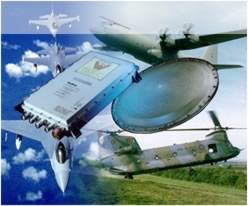Home>>Some of our Customers>>Aircraft Navigation system
| Customer Advantage: Small quantities were needed for research, but with high flexibility to cope with whatever the needs turned out to be. | Raytheon Systems Limited (Harlow) manufacture navigation systems for military aircraft. |
 GPS signals, which are received from a constellation of satellites orbiting in space, are weak by the time they reach the earth and they can easily
be disrupted by electrical interference. RSL's anti-jam GPS system is able to recognise these sources of interference and by adjusting the way in which
it receives the interfering signals, reject them, allowing the navigation equipment to function safely, accurately and efficiently.
In military use this allows operations to be carried out with greater accuracy and less risk.
GPS signals, which are received from a constellation of satellites orbiting in space, are weak by the time they reach the earth and they can easily
be disrupted by electrical interference. RSL's anti-jam GPS system is able to recognise these sources of interference and by adjusting the way in which
it receives the interfering signals, reject them, allowing the navigation equipment to function safely, accurately and efficiently.
In military use this allows operations to be carried out with greater accuracy and less risk.
RSL is now involved in researching the next generation of GPS/Galileo satellite navigation receivers for use in high integrity civil navigation
applications. This is where HERON and HEART come in. RSL's research needs a small quantity of systems that provide high speed ADCs, FPGAs and C6000
DSPs. They need to retain a large degree of flexibility as it is only during the research that the processing performance of the system will
become established. Upon delivery of their systems RSL engineers received 2 days of on site
training to be certain that they were up to speed on the architecture and development tools. This time was also used to discuss different system
architectures with an expert from HUNT ENGINEERING to see what issues they needed to be aware of.
They use separate RF downconversion circuitry which is interfaced to HERON-IO2 modules.
There the FPGA is used to extract the different satellite channels, and to pass their status on to the C6000. The C6000 processes the information and
closes the loop by setting control registers in the FPGA.
As their project progresses they have the flexibility to add more FPGA or C6000 modules to absorb any unforeseen requirements. When their research is
completed they will use the resulting architecture as the basis for their own custom developed systems.
Update September 2003:
The system has been demonstrated and works well. "We
have clocked in data samples at over 51Mhz, processed them in the FPGA, and
provided correlated data at a 1mS rate to the DSP. The DSP has buffered and
forwarded this and other data to the host PC for logging and realtime graphing.
" said Trevor Fillary, Programme manager.
For more information see http://www.raytheon.co.uk/what_we_do/navigational_systems_defence.html